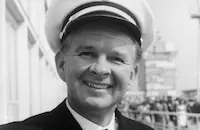Clay Pigeon

Brief Synopsis
Cast & Crew
Tom Stern
Telly Savalas
Robert Vaughn
John Marley
Burgess Meredith
Ivan Dixon
Film Details
Technical Specs

Synopsis
After falling on an enemy grenade in Vietnam, Joe Ryan is awarded the Silver Star and returns home to Los Angeles. Feeling he is living on "borrowed time," Joe grows his hair long, smokes marijuana and becomes a hippie. One day, Joe encounters a police officer abusing a teenager on the Sunset Strip and playfully distracts the officer by sending a transmission to the sheriff's headquarters over the official's motorcycle radio. Jailed for misconduct, Joe attracts the attention of Frank Redford, a ruthless agent from the Washington offices of the Federal Bureau of Narcotics, who, impressed by the fact that Joe won a Silver Star, tries to convince him to help trap Tallin, a syndicate drug lord operating out of Los Angeles who uses the alias of Henry Neilson. After Joe refuses to become a "clay pigeon," Redford, against the orders of the police captain to leave Joe alone, decides to use him to flush out the drug dealer. Redford arranges for Joe's release, then notifies the press that Neilson escaped after being arrested and hands them a picture of Joe, claiming that he is Neilson. Joe sees the story while staying with an addicted youth named Tracy at a commune operated by teenage runaways. When Neilson spots the article, he sends his two henchmen, Simon and Jason, to catch the imposter. The thugs visit Joe's friend, eccentric sculptor Freedom Lovelace, demanding information about Joe's whereabouts, and when Freedom refuses to cooperate, they beat him senseless. Tracking Joe to the commune, Neilson and his thugs confront Tracy, and when she refuses to tell them where they can find Joe, they give her a lethal dose of heroin. Returning to the commune after the thugs have gone, Joe witnesses Tracy's excruciating death and, enraged, tracks down Redford and thrashes him for his treachery. After Neilson's men kill Joe's estranged wife Angeline and his friend Saddle, a black addict, Joe escapes from an ambush in a deserted Hollywood mansion and leads Neilson and his thugs to the nearly deserted Hollywood Bowl. In the ensuing shootout, Joe kills the drug dealers, then dies of his wounds.

Cast

Telly Savalas

Robert Vaughn

John Marley

Burgess Meredith

Ivan Dixon
Tom Stern
Marlene Clark
Belinda Palmer
Mario Alcalde

Jeff Corey
Marilyn Akin
Pat Mccormack

James Dobson
George Wallace
Renee Tetro
Mark Thomas
Marly Stone
John Quincy Durant
Don Carter
Michael Gwynne
Janet Wood
Don Hansen
Leonard D'john
Ellen Blake
Frank Mitchell
John White
Merie Earl
Andrew Parks
Lee Anthony
Alan Braunstein
Ronald Knight
J. P. Cranshaw
Jerry Brooks

Peter Lawford
Crew
Frank Avianca
Claudia Bousman
Ross Brown
Ronald Buck
Ronald Buck
Buzz Clifford
Scott Conrad
Lorafay Davis
Chester Fox
Doris Grau
Kathe Green
Danford Greene
Jack Gross Jr.
Jack Gross Jr.
Arlo Guthrie
Joe Hooker
Bobby Jameson
Kirby Johnson
Carmen Krear
Kris Kristofferson
Greg Lacava
Taj Mahal
Jerry Mcfarland
Gavin Murrell
Joe O'hare
Ned Parsons
Clark L. Paylow
Clark L. Paylow
Jim Pettinotti
Jerry Randall
David Ronne
Buddy Ruskin
Buddy Ruskin
Alan Stensvold
Tom Stern
Sandy Stundel
Hal Watkins
David Wheeler

Film Details
Technical Specs

Quotes
Trivia
The film's premiere in Boston benefited Project Turnabout, a drug rehab program in Hull, Mass.
Notes
Cast and crew credits for Clay Pigeon were taken from a cutting continuity contained in the film's copyright files. Although the continuity lists the name of the makeup man as "Gregory La Cava," all other contemporary sources list him as "Greg LaCava." It is likely that the continuity contained a typographical error. According to an August 1969 Hollywood Reporter news item, Buddy Ruskin, who wrote the film's story and screenplay with Jack Gross, Jr., was originally to develop the film for Acquarian Productions owned by songwritersTommy Boyce and Bobby Hart. Tracom, the company that provided the financing for Clay Pigeon, was an independent production company owned by Tom Stern, the film's producer, co-director and star.
According to a January 1971 Daily Variety article, Stern, who wrote, starred in and produced the 1969 AIP film Hell's Angels '69 (see below), used the deferred profits he earned on that picture to finance Clay Pigeon. In exchange for Tracom providing the financing for Clay Pigeon, Stern signed a deal granting M-G-M distribution rights to the film, with M-G-M to receive 35% of the distributor's gross for the first $1,000,000 in receipts, after which Tracom would split the receipts 50-50 for the U.S. and Canada. Under the deal, M-G-M would pay for the prints and advertising, and Tracom would retain the distribution rights for the rest of the world.
The Daily Variety article noted that a "spectacular" car chase stunt featured in the film helped secure the M-G-M deal. Tracom arranged to defer the salaries of its staff as well as those of actors Telly Savalas, Robert Vaughn and Burgess Meredith, thus giving the company enough cash to hire Peter Lawford for a cameo role. Although the film began with Lane Slate as the director, as noted inVariety review, Stern took over direction from Slate. Clay Pigeon was the only film directed by Stern, who shared an onscreen direction credit with Slate.
According to Filmfacts, location filming was done in Los Angeles and Palm Springs, CA. Although publicity information located in the film's production files at the AMPAS Library noted that Susan Forrest was to play "Lisa," Forrest's appearance in the released film has not been confirmed. Clay Pigeon marked the first and only film appearance of Marilyn Akin. A modern source adds Robert Jon Carlson to the cast.

Miscellaneous Notes
Released in United States 1971
Released in United States 1971












